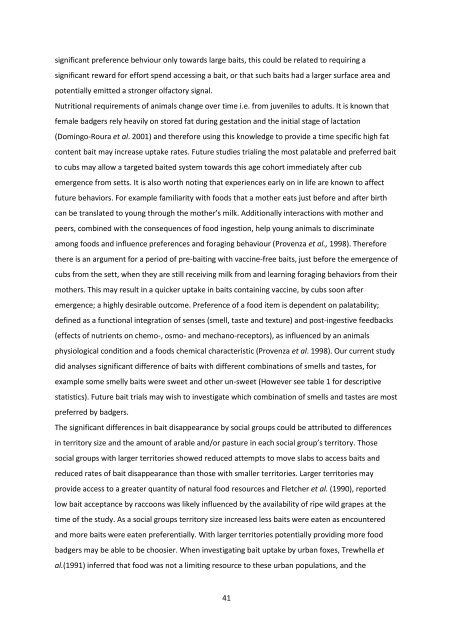Developing an oral bait for badger vaccination - Exeter Research ...
Developing an oral bait for badger vaccination - Exeter Research ...
Developing an oral bait for badger vaccination - Exeter Research ...
You also want an ePaper? Increase the reach of your titles
YUMPU automatically turns print PDFs into web optimized ePapers that Google loves.
signific<strong>an</strong>t preference behviour only towards large <strong>bait</strong>s, this could be related to requiring a<br />
signific<strong>an</strong>t reward <strong>for</strong> ef<strong>for</strong>t spend accessing a <strong>bait</strong>, or that such <strong>bait</strong>s had a larger surface area <strong>an</strong>d<br />
potentially emitted a stronger olfactory signal.<br />
Nutritional requirements of <strong>an</strong>imals ch<strong>an</strong>ge over time i.e. from juveniles to adults. It is known that<br />
female <strong>badger</strong>s rely heavily on stored fat during gestation <strong>an</strong>d the initial stage of lactation<br />
(Domingo-Roura et al. 2001) <strong>an</strong>d there<strong>for</strong>e using this knowledge to provide a time specific high fat<br />
content <strong>bait</strong> may increase uptake rates. Future studies trialing the most palatable <strong>an</strong>d preferred <strong>bait</strong><br />
to cubs may allow a targeted <strong>bait</strong>ed system towards this age cohort immediately after cub<br />
emergence from setts. It is also worth noting that experiences early on in life are known to affect<br />
future behaviors. For example familiarity with foods that a mother eats just be<strong>for</strong>e <strong>an</strong>d after birth<br />
c<strong>an</strong> be tr<strong>an</strong>slated to young through the mother’s milk. Additionally interactions with mother <strong>an</strong>d<br />
peers, combined with the consequences of food ingestion, help young <strong>an</strong>imals to discriminate<br />
among foods <strong>an</strong>d influence preferences <strong>an</strong>d <strong>for</strong>aging behaviour (Provenza et al., 1998). There<strong>for</strong>e<br />
there is <strong>an</strong> argument <strong>for</strong> a period of pre-<strong>bait</strong>ing with vaccine-free <strong>bait</strong>s, just be<strong>for</strong>e the emergence of<br />
cubs from the sett, when they are still receiving milk from <strong>an</strong>d learning <strong>for</strong>aging behaviors from their<br />
mothers. This may result in a quicker uptake in <strong>bait</strong>s containing vaccine, by cubs soon after<br />
emergence; a highly desirable outcome. Preference of a food item is dependent on palatability;<br />
defined as a functional integration of senses (smell, taste <strong>an</strong>d texture) <strong>an</strong>d post-ingestive feedbacks<br />
(effects of nutrients on chemo-, osmo- <strong>an</strong>d mech<strong>an</strong>o-receptors), as influenced by <strong>an</strong> <strong>an</strong>imals<br />
physiological condition <strong>an</strong>d a foods chemical characteristic (Provenza et al. 1998). Our current study<br />
did <strong>an</strong>alyses signific<strong>an</strong>t difference of <strong>bait</strong>s with different combinations of smells <strong>an</strong>d tastes, <strong>for</strong><br />
example some smelly <strong>bait</strong>s were sweet <strong>an</strong>d other un-sweet (However see table 1 <strong>for</strong> descriptive<br />
statistics). Future <strong>bait</strong> trials may wish to investigate which combination of smells <strong>an</strong>d tastes are most<br />
preferred by <strong>badger</strong>s.<br />
The signific<strong>an</strong>t differences in <strong>bait</strong> disappear<strong>an</strong>ce by social groups could be attributed to differences<br />
in territory size <strong>an</strong>d the amount of arable <strong>an</strong>d/or pasture in each social group’s territory. Those<br />
social groups with larger territories showed reduced attempts to move slabs to access <strong>bait</strong>s <strong>an</strong>d<br />
reduced rates of <strong>bait</strong> disappear<strong>an</strong>ce th<strong>an</strong> those with smaller territories. Larger territories may<br />
provide access to a greater qu<strong>an</strong>tity of natural food resources <strong>an</strong>d Fletcher et al. (1990), reported<br />
low <strong>bait</strong> accept<strong>an</strong>ce by raccoons was likely influenced by the availability of ripe wild grapes at the<br />
time of the study. As a social groups territory size increased less <strong>bait</strong>s were eaten as encountered<br />
<strong>an</strong>d more <strong>bait</strong>s were eaten preferentially. With larger territories potentially providing more food<br />
<strong>badger</strong>s may be able to be choosier. When investigating <strong>bait</strong> uptake by urb<strong>an</strong> foxes, Trewhella et<br />
al.(1991) inferred that food was not a limiting resource to these urb<strong>an</strong> populations, <strong>an</strong>d the<br />
41
















